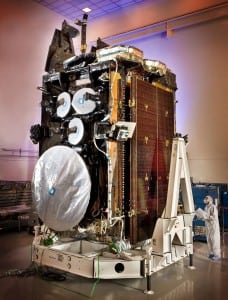Latest News
[Via Satellite 06-26-2014] Northrop Grumman’s protected communications payload for the U.S. Air Force’s third Advanced Extremely High Frequency (AEHF) satellite successfully completed on orbit testing ahead of schedule. The AEHF 3 was launched Sept. 18, 2013 on board a United Launch Alliance (ULA) Atlas 5 rocket, and reached its final position in geostationary orbit in January 2014. Testing involved establishing communication between combinations of EHF terminals on the ground and other terminals prepared to handle the wideband AEHF extended data rates (XDR).
A series of on orbit payload tests were successfully completed in February, after which the fourth Air Force Space Operations Squadron at Schriever Air Force Base in Colo. Took over operations in March from the Space and Missile Systems Center in Los Angeles, Calif.
As a result, AEHF 3 was integrated into the constellation, which provides global, highly secure communications for warfighters on the ground, in the air and by sea. The constellation includes five Military Strategic and Tactical Relay (Milstar) and three AEHF satellites, communicating via satellite-to-satellite crosslinks. Northrop Grumman provided all AEHF payloads to the prime contractor, Lockheed Martin Space Systems.
“With the third AEHF satellite seamlessly integrated into the ‘ring of protection,’ the Northrop Grumman-built crosslinks demonstrated a new first — operations at extended data rates (XDR) on both sides of an AEHF satellite. That wasn’t possible with only two AEHF satellites on orbit,” said Stuart Linsky, vice president of communications at Northrop Grumman Aerospace Systems.
Get the latest Via Satellite news!
Subscribe Now